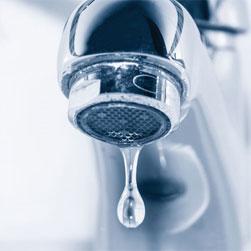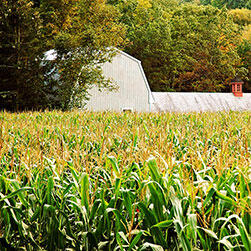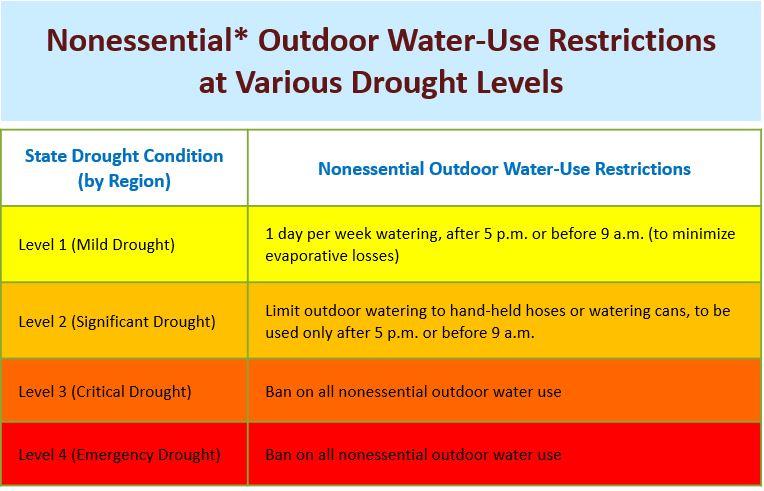*The drought levels shown in the map above are in effect until the next drought declaration
October 10, 2025:
Today, Energy and Environmental Affairs (EEA) Secretary Rebecca Tepper declared that dry conditions in the Islands Region in Nantucket County have worsened to a Level 3–Critical Drought and in Dukes County to a Level 1–Mild Drought. The Northeast Region has improved from Level 2–Significant Drought to Level 1–Mild Drought. The Deerfield and Millers Watersheds have worsened to Level 3–Critical Drought. The Southeast Region remains at a Level 1–Mild Drought and the Western Connecticut River Valley, Central, and Cape Cod Regions are still in Level 2–Significant Drought Conditions.
During September, Massachusetts received between 2 - 6 inches of rainfall. The Central, Western, Cape Cod and Islands recorded rainfall totals 1.5 - 3 inches below normal; the Southeastern Region, including Bristol and Plymouth Counties, experienced near to slightly above normal precipitation (0–2 inches above normal).
Three-month precipitation totals are now generally 40–80% of normal across Massachusetts, with the largest deficits on Nantucket (20–40% of normal). Six-month totals remain within 20% of normal across most of the state, except for Nantucket (40–60% of normal). Although the upcoming rainfall will bring some relief to the southeast part of the state, it may take longer to recover from the precipitation deficits and their influence on groundwater and other indices.
The current drought has caused many impacts to the natural environment including the drying of streams in nearly all regions, lower water levels in lakes and ponds resulting in exposed banks, and the impediment of fish passage out to the ocean. Local water supplies have been impacted with many cities and towns instituting watering restrictions to ensure long-term sustainability.
State agencies will continue to closely monitor and assess conditions across the state, coordinate any needed dissemination of information to the public, and help federal, state, and local agencies prepare additional responses that may be needed in the future. The DMTF will meet again on Thursday, November 6th at 10:00 AM. For further information on water conservation and what residents can do, visit the EEA’s drought and water conservation pages.
Below are recommendations for communities and individuals living and working within a Level 1 – Mild Drought, Level 2 – Significant Drought, and Level 3 – Critical Drought including those utilizing a private well. Residents and businesses are strongly urged to check with their local water system in case more stringent watering restrictions are in place. Many systems may have other more severe local conditions and constraints on water supply.
For Regions in Level 3 – Critical Drought
Residents and Businesses:
- Minimize overall water use
- Ban on all nonessential outdoor water use
- Follow state water conservation actions and any local water use restrictions
- Monitor total household water use shown on your water bill for sudden increases, which often indicate leaks. Use the MA Home Water Use Calculator tool to evaluate household water use.
- Fix any toilet or faucet leaks immediately. Check for leaks in homes and businesses regularly by:
- Checking water meters for constant dial movement
- Using dye tabs to check for toilet leaks
- Conducting regular inspections of all pipes and fixtures, including those located in utility rooms, crawlspaces, and other hidden areas
- Use dishwashers rather than handwashing dishes. Run the dishwasher only on a full load
- Aggressively reduce indoor water use by:
- Reducing shower length and consider using a shower timer
- Running washing machines only on a full load
- Not letting water run while brushing and shaving
- Replacing old fixtures and appliances with water-efficient ones. Make sure toilets, faucets, and showerheads are WaterSense labeled
- Stop all non-essential water use
- Be extra cautious with outdoor fires, grills, and flammable materials
Immediate Steps for Communities/Municipalities:
- Provide timely information on the drought and on water conservation tips to local residents and businesses taking advantage of the state’s library of outreach materials
- Enforce water use restrictions with increasingly stringent penalties
- Strongly discourage or prohibit washing of hard surfaces (sidewalks, patios, driveways, siding); personal vehicle or boat washing
- Establish or enhance water-use reduction targets for all water users, identify top water users and conduct targeted outreach to help curb their use
Short- and Medium-Term Steps for Communities/Municipalities:
- Establish a year-round water conservation program that includes public education and communication, taking advantage of the state’s library of outreach materials
- Implement or establish drought surcharge or seasonal water rates
- Prepare to activate emergency inter-connections for water supply
- Develop or refine your local drought management plan using guidance outlined in the state Drought Management Plan
Officials remind everyone to follow these outdoor fire prevention steps:
- Remember that burning yard waste is prohibited statewide through January and in many communities year-round. Even during open burning season, it always requires a permit and burning leaves is not allowed.
- Refrain from outdoor cooking and heating. Sparks and embers from chimineas, fire pits, and grills can easily ignite dry vegetation, debris, and overhanging branches.
- Use caution with leaf blowers, all-terrain vehicles, and other power equipment. Hot engines, sparks, and spilled gasoline can ignite dry leaves and grass.
- Dispose of ashes from fireplaces and wood stoves in a metal can, douse them with water, and cover them with a tight-fitting lid. These ashes can remain hot enough to ignite combustibles long after the fire goes out: never dump them outdoors or in the trash.
- Extinguish smoking materials in a sturdy ashtray with water or sand. Never toss cigarette butts, matches, or other smoking materials over the edge of a balcony, stub them out on stairs or railings, or toss them in dry vegetation or debris.
For Regions in Level 2 – Significant Drought
Residents and Businesses:
- Minimize overall water use;
- Limit outdoor watering to hand-held hoses or watering cans, to be used only after 5 p.m. or before 9 a.m.;
- Follow local water use restrictions;
- Fix indoor leaks, such as from toilets, faucets, and showers, which result in more than 60 percent of indoor use; and,
- For larger buildings and businesses, conduct water audits to identify areas of leaks and potential water conservation opportunities.
Immediate Steps for Communities/Municipalities:
- Adopt and implement the state’s nonessential outdoor water use restrictions for Drought Level 2 which calls for limiting outdoor watering to hand-held hoses or watering cans, to be used only after 5 p.m. or before 9 a.m. If local restrictions are more stringent, continue to keep them in place during the course of the drought.
- Limit or prohibit washing of hard surfaces (sidewalks, patios, driveways, siding); personal vehicle or boat washing; and,
- Establish water-use reduction targets for all water users, identify top water users and conduct targeted outreach to help curb their use.
Short- and Medium-Term Steps for Communities/Municipalities:
- Establish a year-round water conservation program that includes public education and communication, taking advantage of the state’s library of outreach materials;
- Provide timely information to local residents and businesses;
- Implement or establish drought surcharge or seasonal water rates;
- Check emergency inter-connections for water supply; and,
- Develop or refine your local drought management plan using guidance outlined in the state Drought Management Plan.
For Regions in Level 1 – Mild Drought
Residents and Businesses:
- Minimize overall water use;
- Limit outdoor watering to one day per week from 5:00 p.m. to 9:00 a.m., or less frequently if required by your water supplier;
- Plant only local and drought-resistant species;
- Fix indoor leaks, such as from toilets, faucets, and showers, which result in more than 60 percent of indoor use;
- For larger buildings and businesses, conduct water audits to identify areas of leaks and potential water conservation opportunities;
- Minimize lawn sizes; and,
- Harvest rainwater for outdoor watering.
Communities/Municipalities:
- Establish a year-round water conservation program that includes public education and communication, taking advantage of the state’s library of outreach materials;
- Provide timely drought and water conservation information to residents and businesses;
- Check emergency inter-connections for water supply; and,
- Develop a local drought management plan (learn more Drought Planning Guidance).




